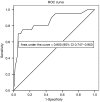Screening for social difficulties in cancer patients: clinical utility of the Social Difficulties Inventory
- PMID: 17895887
- PMCID: PMC2360446
- DOI: 10.1038/sj.bjc.6604006
Screening for social difficulties in cancer patients: clinical utility of the Social Difficulties Inventory
Abstract
Guidelines for psychosocial support have been developed, but there are no standard approaches in routine oncology practice to identify patients experiencing social difficulties. We have designed and evaluated a Social Difficulties Inventory (SDI) to identify patients requiring further assessment and, where appropriate, referral to support services. The purpose of this study was to develop a clinically meaningful SDI scoring system with guidance for oncology staff. Out of 189 patients, 183 completed the SDI and were interviewed by a social work researcher who scored the SDI independently. Comparison of patient/interviewer assessment was good (intraclass correlation 0.61, 95% confidence interval: 0.51, 0.70). Using top 10% of interviewer social distress (SD) scores to indicate 'SD case', the best 'cut-point' was a patient score of > or =10 (sensitivity=0.80; specificity=0.76; 56 out of 183 'cases'). Out of 127 patients, 72 with SD score <10 had individual SDI item rated at a higher level. Following interview, 32 patients were referred to specialist services, 46 given information and 112 had no action taken. An interpretation algorithm developed includes SD score, individual SDI item rating, and an additional general question, illustrated using four case scenarios. In conclusion, general guidance for interpreting the SDI has been developed to enhance health-care professional/patient consultations with a view to identifying patients who may benefit from support, advice or intervention.
Figures



Similar articles
-
The Social Difficulties Inventory (SDI): development of subscales and scoring guidance for staff.Psychooncology. 2011 Jan;20(1):36-43. doi: 10.1002/pon.1705. Psychooncology. 2011. PMID: 20186841
-
Measuring social difficulties in routine patient-centred assessment: a Rasch analysis of the social difficulties inventory.Qual Life Res. 2007 Jun;16(5):823-31. doi: 10.1007/s11136-007-9181-9. Epub 2007 Apr 3. Qual Life Res. 2007. PMID: 17404900
-
Routine assessment of social difficulties in cancer patients: are we opening Pandora's box?Support Care Cancer. 2009 Nov;17(11):1425-32. doi: 10.1007/s00520-009-0690-7. Epub 2009 Jul 11. Support Care Cancer. 2009. PMID: 19593591
-
Novel Augmentation Strategies in Major Depression.Dan Med J. 2017 Apr;64(4):B5338. Dan Med J. 2017. PMID: 28385173 Review.
-
[Psychometric characteristics of questionnaires designed to assess the knowledge, perceptions and practices of health care professionals with regards to alcoholic patients].Encephale. 2004 Sep-Oct;30(5):437-46. doi: 10.1016/s0013-7006(04)95458-9. Encephale. 2004. PMID: 15627048 Review. French.
Cited by
-
Development and validation of the patient roles and responsibilities scale in cancer patients.Qual Life Res. 2018 Nov;27(11):2923-2934. doi: 10.1007/s11136-018-1940-2. Epub 2018 Jul 26. Qual Life Res. 2018. PMID: 30051259 Free PMC article.
-
Exploring the implementation of patient-reported outcome measures in cancer care: need for more real-world evidence results in the peer reviewed literature.J Patient Rep Outcomes. 2018 Dec 27;2(1):64. doi: 10.1186/s41687-018-0091-0. J Patient Rep Outcomes. 2018. PMID: 30588562 Free PMC article. Review.
-
Patient-reported outcome measures of the impact of cancer on patients' everyday lives: a systematic review.J Cancer Surviv. 2017 Apr;11(2):211-232. doi: 10.1007/s11764-016-0580-1. Epub 2016 Nov 10. J Cancer Surviv. 2017. PMID: 27834041 Free PMC article.
-
Integrating patient reported outcomes with clinical cancer registry data: a feasibility study of the electronic Patient-Reported Outcomes From Cancer Survivors (ePOCS) system.J Med Internet Res. 2013 Oct 25;15(10):e230. doi: 10.2196/jmir.2764. J Med Internet Res. 2013. PMID: 24161667 Free PMC article.
-
Health-related quality of life after treatment for bladder cancer in England.Br J Cancer. 2018 May;118(11):1518-1528. doi: 10.1038/s41416-018-0084-z. Epub 2018 May 14. Br J Cancer. 2018. PMID: 29755116 Free PMC article.
References
-
- Aaronson NK, Ahmedzi S, Bergamn B, Bullinger M, Cull A, Duez NJ, Filiberti A, Fletchner H, Fleishman SB, Dehaes JCJM, Kaasa S, Klee S, Osoba D, Razavi D, Rofe PB, Schraub S, Sneeuw K, Sullivan M, Takeda F (1993) The European Organization for Research and Treatment of Cancer QLQ-C30: a quality of life instrument for use in international clinical trials in oncology. J Natl Cancer Inst 85: 365–376 - PubMed
-
- Bonevski B, Sanson-Fisher R, Girgis A, Burton L, Cook P, Boyes A (2000) Evaluation of an instrument to assess the needs of patients with cancer. Cancer 88: 217–225 - PubMed
-
- Canadian Association of Psychosocial Oncology (1999) National Psychosocial Oncology Standards for Canada, 9 July 1999 (Board Approved September 1999). http://www.capo.ca/eng/finalstandards.asp
-
- Carelle N, Piotto E, Bellanger A, Germanaud J, Thuillier A, Khayat D (2002) Changing patient perceptions of the side effects of cancer chemotherapy. Cancer 95: 155–163 - PubMed
Publication types
MeSH terms
LinkOut - more resources
Full Text Sources

